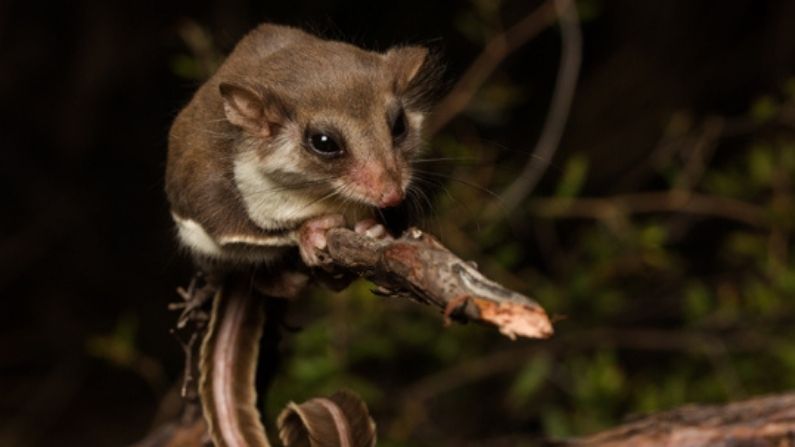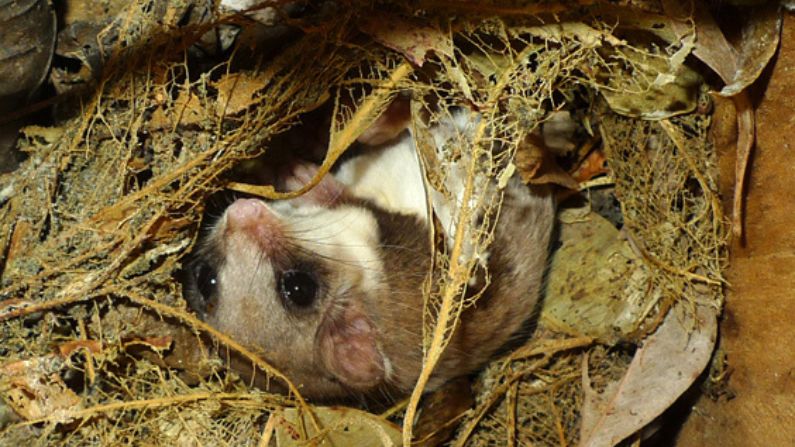Feathertail gliders
© Canva NFP
The feathertail glider (Acrobates pygmaeus) is the smallest gliding marsupial in the world, named for its long feather-shaped tail. The scientific name for this species means pygmy acrobat. A second species, the broad-toed feathertail glider (Acrobates frontalis), has been recognised (Harris, 2015) based on unpublished genetic studies and cryptic morphological differences in toe and tail characteristics. Feathertail gliders spend up to 87 per cent of their time in trees at heights greater than 15 metres making them the most cryptic and rarely seen of all the glider species.
Quick facts
COMMON NAME:
Feathertail glider (Broad-toed feathertail glider, Narrow-toed feathertail glider)
ALSO KNOWN AS:
pygmy gliding possum, pygmy glider, pygmy phalanger, flying phalanger and flying mouse
SCIENTIFIC NAME:
- Broad-toed feathertail glider (Acrobates frontalis)
- Narrow-toed feathertail glider (Acrobates pygmaeus)
FAMILY:
Acrobatidae
QLD CONSERVATION STATUS:
Least Concern
NATIONAL CONSERVATION STATUS:
Not listed
How we help gliders
Through its dedicated Queensland Glider Network, Wildlife Queensland has been educating communities and raising awareness of the importance of gliders and revegetating glider habitat, installing nest boxes in areas where hollow-bearing trees are limited, implementing monitoring programs for local glider populations, and enhancing vital glider habitat.
 © Jari Cornelis
© Jari Cornelis
Did you know?
Feathertail gliders have the ability to run up vertical planes of glass and it is assumed that this skill is what allows them to run around the trunk and branches of smooth-barked gum trees.

Threats to feathertail gliders
- Predation by feral species, including dogs, cats, and foxes
- Habitat loss and fragmentation.
Home range
- Feathertail gliders have a home range of 0.4-2.1 hectares and usually have a population density of 0.01-0.4 individuals per hectare.
- Natural predators in their range include ghost bats, owls, kookaburras, and the small agile antechinus. Other predators include lizards and snakes.
Distribution
Feathertail gliders occur down the east coast of Australia. They are found in Queensland, New South Wales, Victoria and some parts of South Australia.
Description
Feathertail gliders have a mouse-sized body with grey-brown fur on the back and a white underside. The distinctive tail is quill-like and hairless except for a fringe of long stiff hairs down either side that resemble a feather.
Body measurements:
- Head-body length, 65-80 mm.
- Tail length, 70-80 mm.
- Weight, 10-15 grams.
The gliding membrane extends from elbow to knee and is thicker than other glider species.
Signs
- Feathertail gliders are usually silent, but when distressed they will hiss. Other vocalisations include ‘ticking’, ‘popping’ and a ‘psss-psss-psss’ sound.
- Droppings are similar to those of the house mouse in size and are pointed at both ends. Droppings are 5 mm long and 2 mm wide and are composed of very fine particles.
Habitat
- Feathertail gliders are found in most treed habitats and commonly occur in tall wet or dry forests.
- They can live in the rainforest at all altitudes.
- They are even known to occur in parks and backyards.
Ecology
Life history
Feathertail gliders can live in large groups of up to 30 individuals and they are known to nest in artificial nest boxes, even meter boxes and telephone junction boxes. This behaviour assists in maintaining body temperature as their small size makes them susceptible to heat loss. Females have been documented to live up to 8 years.
Breeding
Feathertail gliders commonly give birth between July and January, however, northern populations can breed at any time of the year. Litter size is between 2-4 young, and they will have up to 2 litters per year. Litters commonly have more than 1 father.
Females will look after the young of other females that share the nest. Not all females within the same nest breed at the same time. Growth is slow for such a small marsupial and the material investment is high. Their nest is commonly made up of eucalyptus and acacia leaves that form a 6-8 cm sphere shape.
Females reach sexual maturity at 8 months of age whereas males reach sexual maturity at 12 months of age.
Food
Their diet consists of insects, plant exudates, pollen, honeydew, nectar, and seeds. The gliders’ long, brushy tongues assist with feeding on pollen — their predominant source of protein — and nectar.
They may also feed on pollen that attaches to their fur after contact with flowers.
Mitigation practices
- Installation of nest boxes.
- Keeping cats locked up at night.
More information
Publications & papers
- Goldingay, R.L., Grimson, M.J., and Smith, G.C. (2007). Do feathertail gliders show a preference for nest box design? Wildlife Research 34: 484-490.
- Hackett, D.L., and Goldingay, R.L. (2001). Pollination of Banksia spp. By non-flying mammals in north-eastern New South Wales. Australian Journal of Botany 49: 637-644.
- Harper, M.J., McCarthy, M.A., and van der Ree, R. (2005). The use of nest boxes in urban natural vegetation remnants by vertebrate fauna. Wildlife Research 32: 509-516.
- Harris, J.M. (July 2015). “Acrobates pygmaeus (Diprotodontia: Acrobatidae)”. Mammalian Species. 47 (920): 32–44, https://doi.org/10.1093%2Fmspecies%2Fsev003
- Jackowiak, H, Godynicki, S. (2007). Light and scanning electron microscopic study on the structure of the lingual papillae of the feathertail glider (Acrobates pygmeus, Burramyidae, Marsupialia).
- Parrott, M.L., Ward, S.J. and Taggart, D.A. (2005). Multiple paternity and communal maternal care in the feathertail glider (Acrobates pygmaeus). Australian Journal of Zoology 53: 79-85.
- Smith, G.C., and Agnew, G. (2002). The value of ‘bat boxes’ for attracting hollow dependent fauna to farm forestry plantation in southeast Queensland. Ecological Management and Restoration 3: 37-47.




